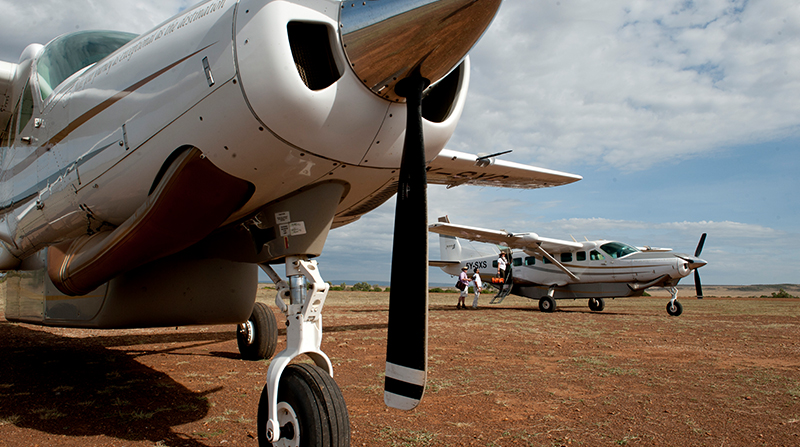

Scenic Air Safaris Takes Experiences In Kenya To New Heights. Credit: Scenic Air Safaris
There is no better way to connect with wildlife and create lasting memories than by experiencing an African safari. One Kenya-based safari company has designed an eye-opening journey that supports conservation efforts without skimping on luxury.
In 2017, Ker & Downey luxury tour operators and Scenic Air Safaris, Kenya’s only full-service flying safari company, debuted a nine-day tour of reserves focusing on African animals deemed endangered by the IUCN Red List of Threatened Species, a tally that includes lions and cheetahs in the Masai Mara, African elephants in Samburu, and wild dogs, Grevy’s zebras and black rhinos in Laikipia.
Up to 10 passengers and a guide travel to each site on Scenic Air’s sleek Cessa Grand Caravan aircraft (featuring plush swivel seats and panoramic windows), viewing Kenya from above, a perspective few visitors ever get to see.
“We’ve got so many beautiful places in Africa with no accessibility or very limited accessibility,” says Scenic Air Safari’s managing director Torben Rune. “Every time we fly through these unique and rare places across Africa and we see a beautiful little lake or mountain, the pilots log it. We’re building a database of information on amazing locations and strips.”
Here are the highlights from our unforgettable trip.
Masai Mara National Reserve
Begin your trek in Nairobi, Kenya’s bustling capital, before boarding the spacious private jet and soaring over the Great Rift Valley and into the Masai Mara National Reserve. Galloping zebras and gracefully striding giraffe are immediately visible from above, while pods of hippos float like shiny buoys in the Mara River.
Each scenic flight ends with a smooth landing on a private airstrip, where you’ll be greeted by highly specialized guides with detailed knowledge of the flora and fauna of each area. Check into The Spirit of the Masai Mara, a boutique game lodge in the Siana Conservancy that features 10 spacious suites built with stone walls and coconut palm roofs. View frolicking baboons from the safety of your soaking tub and take in the expansive vista from your private veranda each morning.
The property is unfenced, like most Kenyan lodges, so spear-wielding warriors from the local Maasai tribe protect the land and act as nighttime escorts.
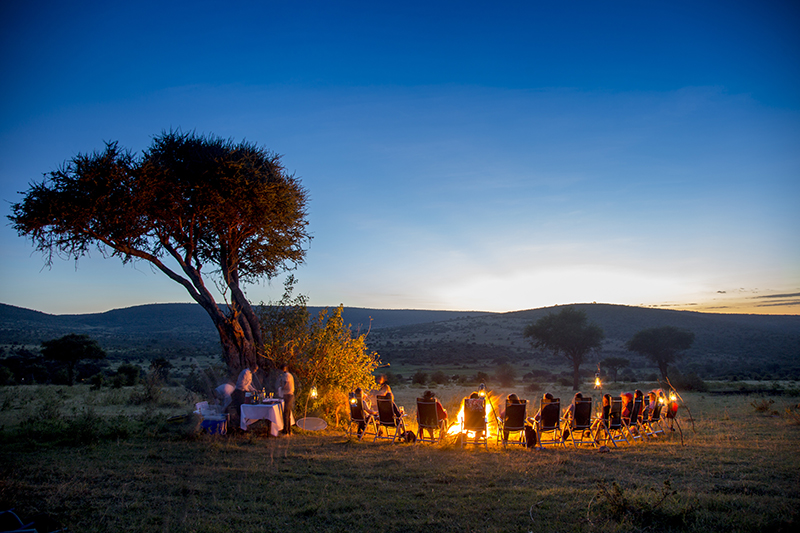
Relaxing at The Spirit of the Masai Mara Lodge. Credit: Scenic Air Safari
No one knows Kenya’s land and its inhabitants like the Maasai and Samburu tribesmen, pastoralists who grew up alongside the region’s native wildlife. In addition to the knowledgeable guides employed by each lodge, Scenic Air Safari brings in experts on each endangered species, like lion specialist David Mascall and cheetah whisperer Dr. Elena Chelysheva, who discuss their research and conservation efforts before accompanying you on scenic game drives.
An expanse of preserved savannah wilderness dotted with acacia trees, Masai Mara National Reserve offers a prime perch for big cat sightings. There are fewer than 20,000 lions in the world and around a quarter of them live here, and it is still one of the best spots on the planet to see cheetahs, though their numbers have halved across the continent since the 1970s due to habitat loss. Between July and October, nearly 2 million wildebeest, zebras and antelopes also migrate through the Serengeti-Masai Mara ecosystem, making for the year’s best viewing.
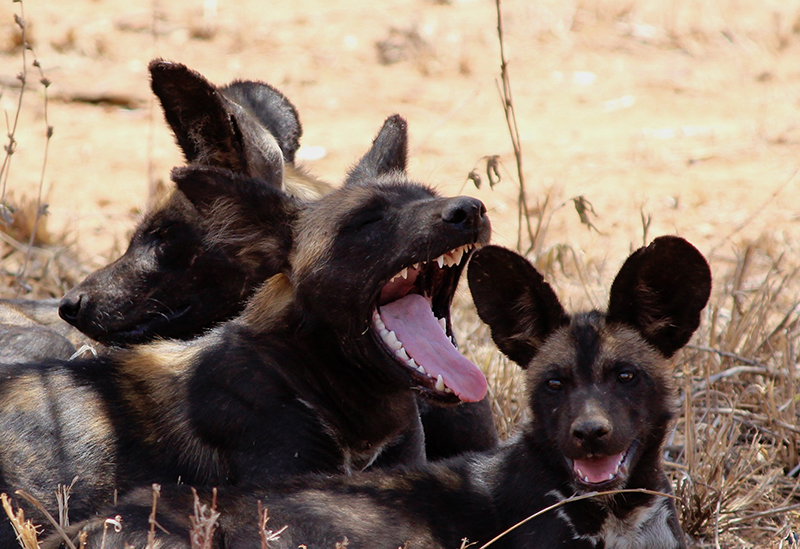
Wild Dogs. Credit: Scenic Air Safari
Loisaba Conservancy—Laikipia
The rolling plains sprout into green hilly farmland on the way — luckily, a nine- to 10-hour drive becomes just an hour-and-a-half ride by air — to the next stop. Masses of pink flamingos dot Lake Elementaita, taking flight in formation as the plane passes over the emerald-green water.
At Loisaba Conservancy, the focus of the trip is on wild dogs, a population quickly nearing extinction due to rabies and the spread of distemper by their domesticated cousins. Get an up-close look at the species with conservationists like Ambrose Letoluai, who are hard at work tracking the wild dogs so scientists can dart and vaccinate them.
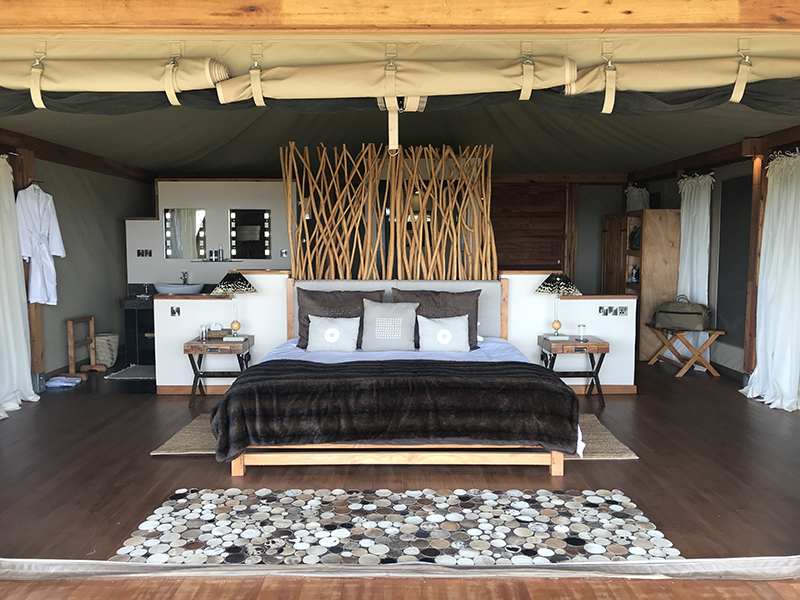
Loisaba Tented Camp. Credit: Veronica Meewes
Each day of thrilling game drives ends with a sundowner whereby you and your fellow adventurers congregate outside over gin and tonics to toast the setting sun and the day’s discoveries. Back at Loisaba Lodge, enjoy Kenyan cuisine like nyama (stewed curried beef), sukuma wiki (braised cabbage greens), ugali (maize porridge) and kachumbari (tomato-onion salad) before retiring to the Loisaba Tented Camp.
This Elewana Collection camp spares no expense in creating elegant, well-designed tents equipped with large private decks that allow for unobstructed views across Laikipia to Mount Kenya. For a one-of-a-kind experience, book one of Loisaba’s starbeds (four-poster beds on raised platforms) and sleep under the glittering African sky.
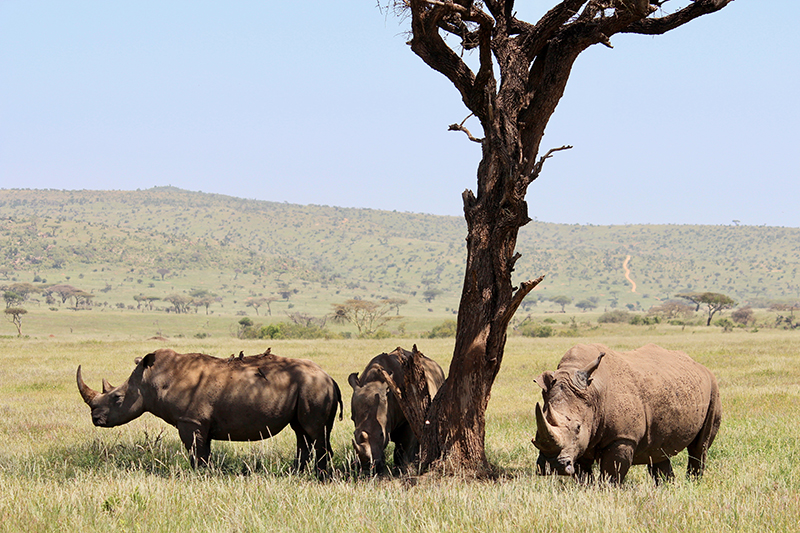
White Rhinos. Credit: Scenic Air Safari
Lewa Wildlife Conservancy
The next destination is Lewa Safari Camp, located within the lush grasslands of the acclaimed Lewa Wildlife Conservancy, where Mount Kenya frames the view to the south. Started in 1983, Lewa was the first private conservancy in Kenya (there are now 160 community-based conservancies across the country).
Originally founded as a rhino sanctuary, the conservancy has since expanded to include an elephant-monitoring program, a Grevy’s zebra breeding program (the world’s largest population can be found here) and various projects studying predators, livestock and how they all interact in the wild.
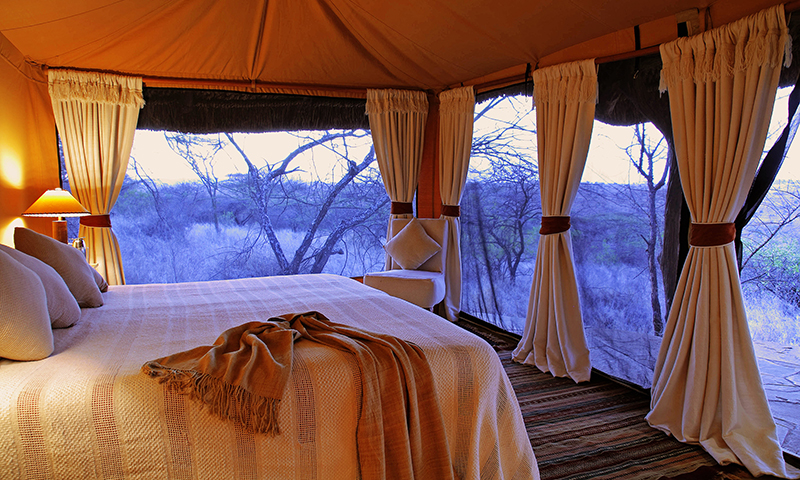
Lewa Safari Camp. Credit: Scenic Air Safari
At Lewa, rhino scientist Ian Lemaiyan leads game drives across the land, where 141 black and white rhino are protected by armed guards — the conservancy hasn’t had a poaching incident in five years. For a $2,500 donation, you can participate in notching a rhino’s ear, a method rangers use to identify and study each individual animal. After a day in the field, forego a sundowner in lieu of a fireside cocktail and dinner in Lewa Safari Camp’s welcoming lodge.
Samburu National Reserve
The last stop on this life-changing journey is Samburu National Reserve, where the Save the Elephants research center has studied more than 1,000 animals since esteemed elephant conservationist Iain Douglas-Hamilton founded the charity in 1993. The organization also pioneered the use of GPS collars; it’s currently tracking 300 elephants across Africa. Thanks to the collaborative efforts of STE, the Kenya Wildlife Service and the community, the proportion of illegally killed elephants (poached for ivory) plummeted from 72 percent in 2012 to 38 percent in 2015.
A game drive in Samburu is unlike any other. Here, the guides know each individual elephant and the safari vehicle becomes a part of the herd as the awe-inspiring creatures interact all around it. Douglas-Hamilton’s daughter Saba grew up around these same elephants and, in 2001, the well-known conservationist and TV personality opened the family’s luxury tented eco-lodge, Elephant Watch Camp, pioneering the concept of conservation tourism.
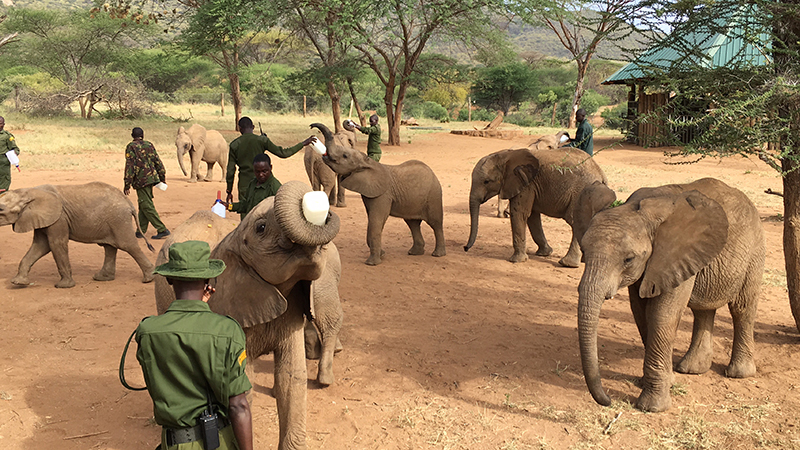
Elephant Feeding. Credit: Scenic Air Safari
Upon arrival, you are invited to take off your shoes and feel Africa under your feet. Each of the 10 tented suites is draped with vivid fabrics and decorated with naturally carved furniture and bohemian pillows. The water is heated naturally using the sun and nets are all that separate the living quarters from the stunning African landscape. The camp is staffed by 40 Samburu tribesmen who craft cuisine using the region’s organic bounty. Local women sell their intricate, brightly colored beaded necklaces and earrings out of the lodge’s gift shop.
“What we’re trying to do here is harness tourism as a tool for conservation,” Douglas-Hamilton explains. “The way we do it here is by employing the local people so they see definite benefits from getting involved in protecting the wildlife, and by opening up people’s eyes and hearts to what is happening to species in a completely different part of the world. By helping people fall in love, you then find that they very quickly want to get involved.”
